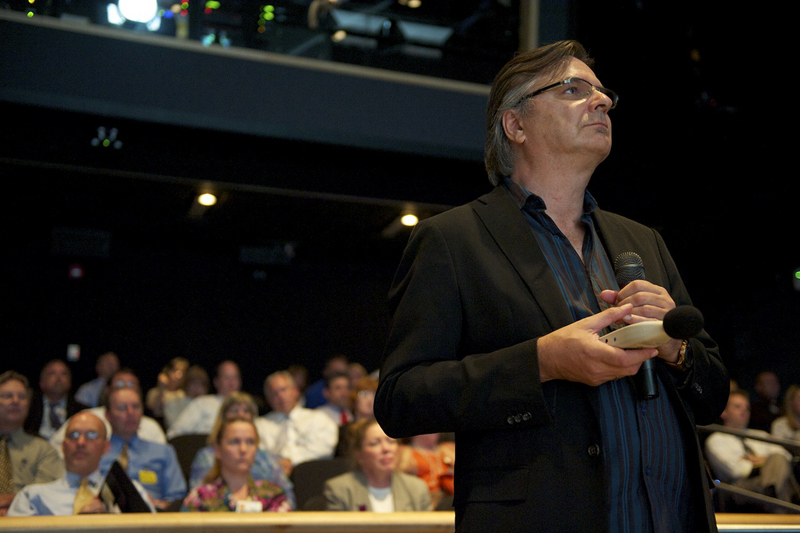Sonic Arts R&D Licenses Audio Beamforming Technology to Comhear
MyBeam Spatial Interactive Telepresence to be Showcased at Mobile World Congress
San Diego, February 18, 2014 -- The University of California, San Diego and Comhear, Inc., a transformational, audio technology and wearables company, today announced that they are collaborating on the latest in audio conferencing technology. Comhear has prototyped the first in a series of revolutionary new products designed to let users customize their listening environment, based on an exclusive license for audio beamforming technology developed by researchers in the Qualcomm Institute, the UC San Diego division of the California Institute for Telecommunications and Information Technology (Calit2).
|
“The work being done at UC San Diego under the leadership of Research Director Peter Otto is truly astounding, and we believe this agreement has the potential to generate a variety of new beamforming-based products and services for years to come,” said Comhear founder and CEO Randy Granovetter. “There is nothing like MyBeam on the market today, and with this collaboration between Comhear and UCSD, we intend to create consumer and enterprise products and services for audio beamforming.”
In early February, Comhear and UC San Diego signed a three-year sponsored research contract for work to be carried out in the Sonic Arts R&D group of the Qualcomm Institute. The research will build on the original Sonic Arts R&D work on small-format audio beamforming licensed by Comhear. The parties have also signed a license agreement providing Comhear with the right to commercially exploit the patented technologies.
The MyBeam device links to a user’s laptop, tablet or smartphone, allowing the user to reshape the incoming audio. Participants in a teleconference or webconference can control the acoustic position of other participants relative to where the user is located. Instead of all voices on a conference call seeming to come from a single point in space, beamforming allows the user to make each voice appear to come from a different location. So if you’re in New York and you’re conferencing with research collaborators in Tokyo and Amsterdam, you can make the Tokyo audio come from the west, and the Amsterdam caller from the east. The system also allows the user to move participants closer or farther away – providing control over the audio ‘mix’ of the conference call.
|
“Our technology allows us to provide private listening areas in a public space, and this includes spatializing source audio for a single user to create a virtual surround-sound effect,” said Otto. “We can target discrete audio beams to a primary user’s left and right ears, while everyone else in the vicinity would hear a different audio track that masks this privacy feature.”
MyBeam Spatial Interactive Telepresence shows significant improvement in the teleconference or webconferencing experience, enabling a new level of clarity and intelligibility for significantly better comprehension and meeting efficiency. A prototype for the device will be demonstrated at the Mobile World Congress in Barcelona. WowWee, a UC San Diego technology licensee of robotics, will be a distributor of Comhear’s MyBeam product line and services.
About Sonic Arts R&D at UCSD
The Sonic Arts R&D group in Calit2’s Qualcomm Institute at UC San Diego provides applied research and development services to major industry and government sponsors in need of cutting-edge digital audio solutions. On a selective basis, the group is also available to venture-funded enterprises seeking to introduce disruptive technologies in the digital audio space. Sonic Arts R&D’s mission is to create high-impact solutions that can be deployed in the market or in the field within a short-to-medium timeframe. The group’s sponsors and affiliates include institutions of national and international prominence, including Meyer Sound Labs, Qualcomm, Inc., Skywalker Sound (a Lucasfilm company), NASA, Disney, Pacific Interface, Inc., NTT, Motorola Mobility, Kyocera, and King Abdullah University of Science and Technology. http://sonicarts.calit2.net.
About Comhear, Inc.
Founded in 2013 by the former founder and CEO of Jabra, Randy Granovetter, Comhear, Inc. is a transformational audio technology company. It creates products and solutions that really revolutionize the listening experience in three ways: wearables, software, and amazing sound beaming technology. Its new wearables category is defined as “In the Service of Sound” and the company produces “Audio that Feels Good, Sounds Great, and is Good for You!” The company’s product lines include the EarPuff technology based on proprietary patented BioFoam™, Kinetic Audio Processing (KAP) technology which is a perfect complement to EarPuff, and its Playbutton line of products. For more information, visit http://www.comhear.com and http://www.playbutton.com.
Related Links
Qualcomm Institute of Calit2
Sonic Arts R&D Group
Comhear, Inc.
Media Contacts
Doug Ramsey/Qualcomm Institute, 858-822-5825, dramsey@ucsd.edu; Gordon Schenk/Comhear, 619-851-6691, gordon.schenk@comhear.com , or Lisa Porter, Porter Creative, 949-752-5891, lporter@portercreative.com.



